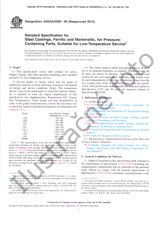Potrebujeme váš súhlas na využitie jednotlivých dát, aby sa vám okrem iného mohli ukazovať informácie týkajúce sa vašich záujmov. Súhlas udelíte kliknutím na tlačidlo „OK“.
ASTM E2350-19
Standard Guide for Integration of Ergonomics/Human Factors into New Occupational Systems
NORMA vydaná dňa 15.8.2019
Informácie o norme:
Označenie normy: ASTM E2350-19
Poznámka: NEPLATNÁ
Dátum vydania normy: 15.8.2019
Kód tovaru: NS-968566
Počet strán: 9
Približná hmotnosť: 27 g (0.06 libier)
Krajina: Americká technická norma
Kategória: Technické normy ASTM
Kategórie - podobné normy:
Anotácia textu normy ASTM E2350-19 :
Keywords:
ergonomics, human factors, occupational system, process design, work, work evaluation,, ICS Number Code 03.100.30 (Management of human resources),13.180 (Ergonomics)
Doplňujúce informácie
| Significance and Use |
|
5.1 Integrating ergonomic principles into new occupational systems may help businesses develop processes that do not exceed worker capabilities and limitations. 5.2 Jobs and tasks that conform to worker capabilities and limitations may be performed more efficiently, safely, and consistently than those that do not. 5.3 The application of ergonomic principles to the processes involved in occupational systems may help avoid system failures and inefficiencies. 5.4 The integration of ergonomic principles at the earliest stages of process concept and design may facilitate appropriate design, layout, and allocation of resources and may reduce or eliminate the necessity for later redesign that could have been foreseen. 5.5 Designing jobs that fit the capabilities of larger population segments may increase an organization's accessibility to the available labor pool. 5.6 The integration of ergonomic principles into occupational systems may increase profit by lowering direct and indirect costs associated with preventable losses, injuries, and illnesses. 5.7 The bibliography contains a list of reference materials that may be useful in particular applications. All appendixes are nonmandatory. |
| 1. Scope |
|
1.1 This guide is intended to assist in the integration of ergonomic principles into the design and planning of new occupational systems from the earliest design stages through implementation. Doing so may reduce or eliminate the necessity for later redesign that could have been foreseen. 1.2 This standard does not purport to address all of the safety concerns, if any, associated with its use. It is the responsibility of the user of this standard to establish appropriate safety, health, and environmental practices and determine the applicability of regulatory limitations prior to use. 1.3 This international standard was developed in accordance with internationally recognized principles on standardization established in the Decision on Principles for the Development of International Standards, Guides and Recommendations issued by the World Trade Organization Technical Barriers to Trade (TBT) Committee. |
Odporúčame:
EviZak - všetky zákony vrátane ich evidencie na jednom mieste
Poskytovanie aktuálnych informácií o legislatívnych predpisoch vyhlásených v Zbierke zákonov od roku 1945.
Aktualizácia 2x v mesiaci !
Chcete vedieť viac informácii ? Pozrite sa na túto stránku.




 Cookies
Cookies
